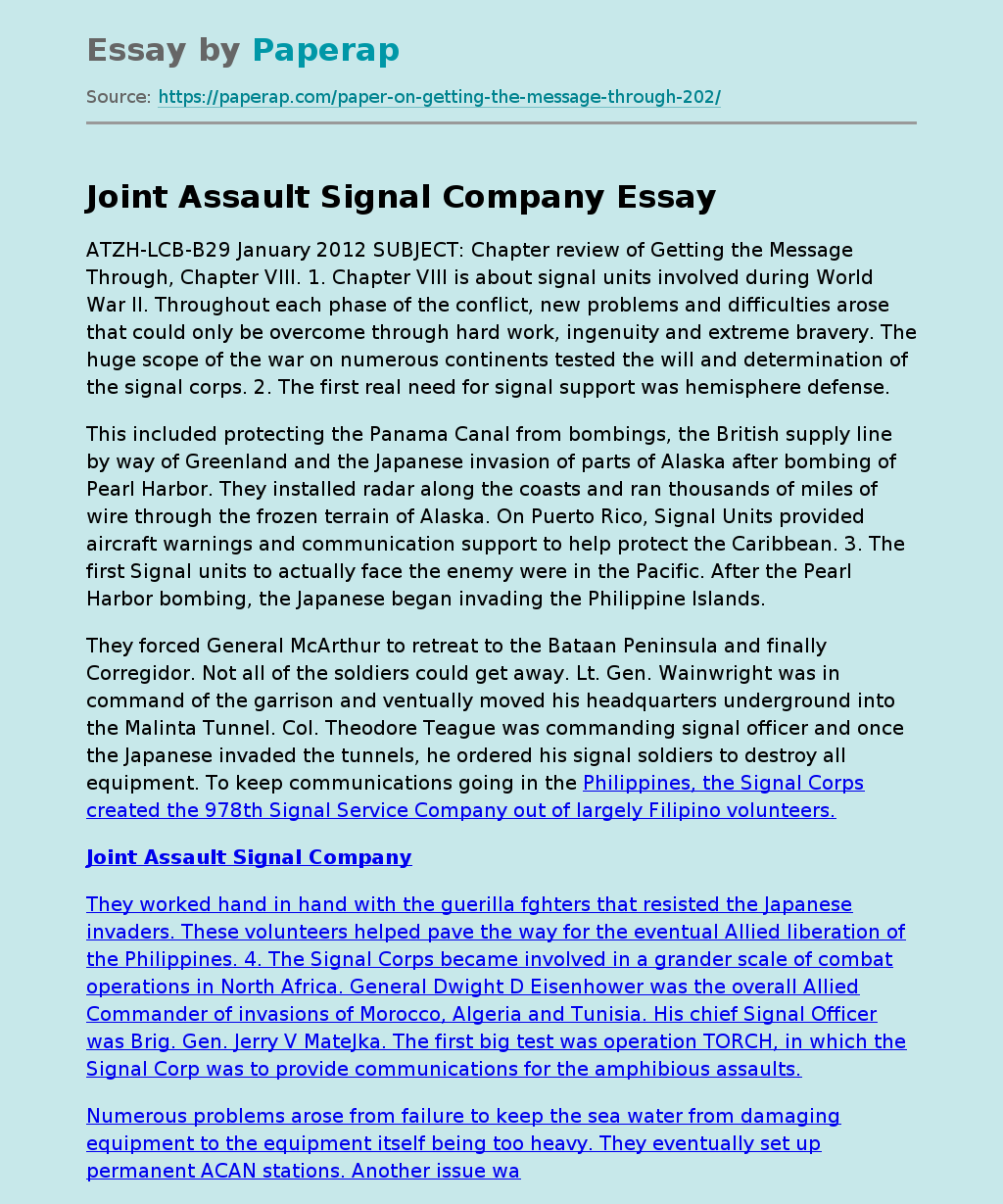Joint Assault Signal Company
Chapter review of Getting the Message Through, Chapter VIII. Chapter VIII is about signal units involved during World War II. Throughout each phase of the conflict, new problems and difficulties arose that could only be overcome through hard work, ingenuity and extreme bravery. The huge scope of the war on numerous continents tested the will and determination of the signal corps. The first real need for signal support was hemisphere defense. This included protecting the Panama Canal from bombings, the British supply line by way of Greenland and the Japanese invasion of parts of Alaska after bombing of Pearl Harbor.
They installed radar along the coasts and ran thousands of miles of wire through the frozen terrain of Alaska.
In Puerto Rico, Signal Units provided aircraft warnings and communication support to help protect the Caribbean. The first Signal units to actually face the enemy were in the Pacific. After the Pearl Harbor bombing, the Japanese began invading the Philippine Islands. They forced General McArthur to retreat to the Bataan Peninsula and finally Corregidor.
Not all of the soldiers could get away. Lt. Gen. Wainwright was in command of the garrison and ventually moved his headquarters underground into the Malinta Tunnel. Col. Theodore Teague was commanding signal officer and once the Japanese invaded the tunnels, he ordered his signal soldiers to destroy all equipment.
They worked hand in hand with the guerilla fghters that resisted the Japanese invaders. These volunteers helped pave the way for the eventual Allied liberation of the Philippines.
The Signal Corps became involved in a grander scale of combat operations in North Africa. General Dwight D Eisenhower was the overall Allied Commander of invasions of Morocco, Algeria and Tunisia. His chief Signal Officer was Brig. Gen. Jerry V MateJka. The first big test was operation TORCH, in which the Signal Corp was to provide communications for the amphibious assaults.
Numerous problems arose from failure to keep the sea water from damaging equipment to the equipment itself being too heavy. They eventually set up permanent ACAN stations. Another issue was the different codes and call signs used by the British Army and Navvy, Royal Air Force and the Army Air Forces. Signal soldiers had to be adaptive and learn on their feet. In helping to plan the Invasion of Normandy on the European front, the Signal Corps became part ot the Services ot Supply. Brig. Gen. illi m S Rumbougn became the theater’s chief signal officer.
He was faced with signal planning for the largest military operation of the war. This included establishing system of priorities for telephone traffic and allocating frequencies for the 90,000 transmitters needed for the operation. He also created the Joint Assault Signal Company OASCO) to provide signal support for the amphibious assaults at Omaha and Utah beaches. Also, wenty-eight signal men from the 101st Airborne Signal Company were the first signal men to land in France. They flew in with their SCR-449 radios on gliders.
Multichannel radios were first incorporated in the Normandy invasion. 6. Once Hitler committed suicide and Germany surrendered, the Signal Corps put all their resources in support of the Pacific campaign to finish off the Japanese. The jungles of the numerous islands provided many issues with radio communications. To get the message through, miles and miles of wire were run through the trees without proper equipment. The SCR 300 radio was used to communicate with aircraft or arrangement of supply drops for the advancing Allied forces.
Joint Assault Signal Company. (2019, Dec 05). Retrieved from https://paperap.com/paper-on-getting-the-message-through-202/

